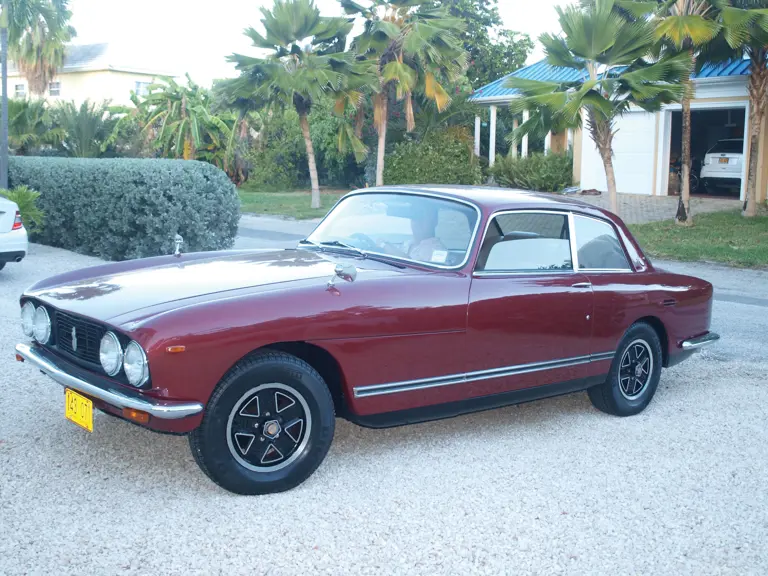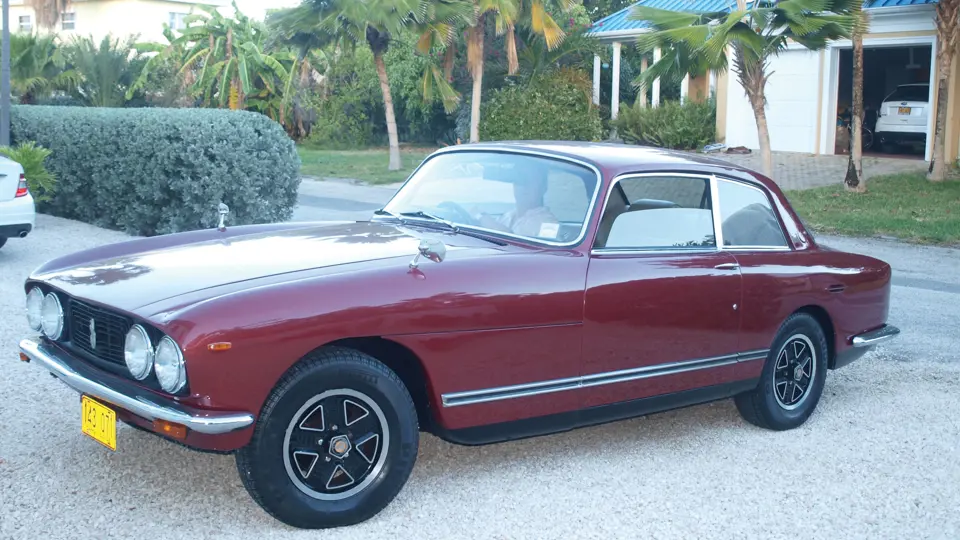The Bristol 411 model was introduced in 1969 and although at a glance may look similar to the previous model, the 410, it was a very different machine altogether. The most significant changes were made mechanically and externally to the body.
There was a reduction in exterior brightwork, in keeping with the changing automotive fashion of the late 1960s and early 1970s. The lines of the car were much simpler and cleaner than the 410, with a mere nod to the sculpted aluminum fins at the rear of the earlier cars. The front and rear screens were larger and more steeply raked, giving the roofline a less upright and smoother look to the eye. Inside an updated interior featured a redesigned dash layout with directional air vents and a new instrument binnacle. The large Bluemels steering wheel was swapped in favor of a smaller 15-inch, thin rimmed, three-spoke type.
Mechanically the car leapt a great distance from the previous 5.2-liter V-8 cars. The new, highly tunable, 6.3-liter ‘wedge-head’ Chrysler 383-cid V-8 changed the dynamic of the car considerably. With a performance camshaft as standard and a four-barrel Carter carburetor the engine power was up by 38-percent from the previous 318 V-8. With a top speed of 140-mph and a 0- to 100-mph time of under 19 seconds the car was no slouch and certainly capable of dusting off the fastest four-seater touring car of the time, the 6.3-liter Mercedes-Benz 300SEL.
On the arrival of the 411 Series 2, self-levelling suspension provided even greater comfort and ensured that the rear suspension would still have full travel regardless of load. Electric windows were standard and an enlarged power steering unit made parking even easier.
The Series 3 introduced a facelifted front end which made the body look even longer and sleeker than before, perhaps even a little more 1970s in style. Quad headlamps provided unrivalled lighting, more than any other production car of the period. At the rear quad exhaust pipes echoed the four lamps at the front. The 383 engine compression ratio was dropped to 9.5:1 which allowed for a smooth low idle and complied with the emission regulations required in the United States. Power was not lost higher in the revs, but some of the crisp throttle response found in the earlier 411s was changed in favor of smooth torque delivery.
The Series 3 was a quiet, refined luxury four-seater which led L J K Setright to “subvert an old Rolls-Royce advertising slogan (at 60-mph you can hear the ticking of the clock) and assert that ‘at a 100-mph in the Bristol you can hear a Rolls-Royce.’”
The 411 Series 4 saw the arrival of the 400 cubic inch Chrysler 6.6-liter V-8 which brought 264-hp at 4,800-rpm. Again there was softer throttle response, but with more torque and a reduction in the compression to 8.2:1. This, along with cleaner air settings to the ignition and carburetor allowed for the ever tightening emission restrictions of the time. Externally the Avon Safety Wheels were introduced, alloys which look wonderfully ‘of the time’. The idea was that the tire would stay on the rim in the event of a puncture, a fact that eccentric ex-racing driver Tony Crook demonstrated in front of motoring journalists and their cameras on an airfield. A detonator burst the a tire at 144-mph and on coming to a halt safely he jumped out of the 411 and announced that ‘he really ought to go and do a proper days work’, before getting in to his private light aircraft and setting off for London and his office at the Showroom.
The Series 5, with the same engine as the 4 and the last in the series, had more safety features fitted. Inertia reel seatbelts, foglamps, headrests in the rear and a black radiator grille helped to differentiate it from the previous model.



 | Fort Lauderdale, Florida
| Fort Lauderdale, Florida


